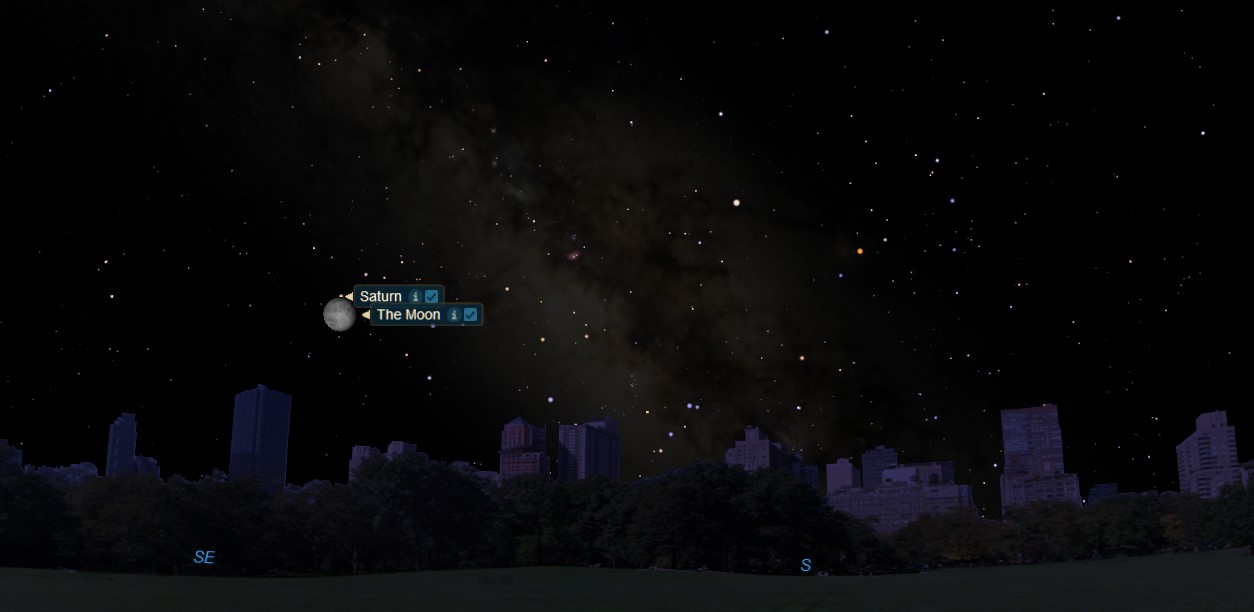
Saturn has been looking stunning lately, and it's preparing to dance close to the moon to display an incredible celestial illusion.
Late tonight (June 18), what are probably the top two objects that people want to look at through a telescope will be visible low in the east-southeast sky: the moon and the "ringed wonder" of the solar system, Saturn. Shortly after 10 p.m. local daylight saving time, you'll readily see the nearly full disk of the moon; glowing sedately like a bright yellow-white "star" to the moon's upper left will be the sixth planet from the sun.
Right now, Saturn shines at magnitude +0.2. If we compared it against the 21 brightest stars, it would rank eighth, making it just a tad brighter than the similarly hued Procyon in the constellation Canis Minor and a trifle dimmer than bluish-white Rigel in Orion.
Related: The Brightest Planets in June's Night Sky: How to See them (and When)
Saturn appears bright in part because it's three weeks away from its opposition to the sun, that moment during a particular period of its visibility when a planet beyond Earth's orbit is passing closest to us.
Another reason Saturn will appear brighter than usual is the fact that its amazing rings are still tilted toward Earth at an inclination of 24 degrees. The rings, which are composed of highly reflective particles of ice, bolster Saturn's apparent brightness.
I have been able to glimpse the rings with very large (25 x 100) binoculars, mounted on a sturdy tripod. Through a 4-inch telescope with a magnification of 100-power, the rings can clearly be seen; with a moderately large instrument of 8-inch aperture at 200-power, the view is nothing short of breathtaking. Viewing Saturn through a 12-inch telescope at 300-power is truly a stupefying experience whether you're seeing it for the first or 10,000th time.
Get the Space.com Newsletter
Breaking space news, the latest updates on rocket launches, skywatching events and more!
Related: Jupiter Shines Over New York City in Gorgeous Skywatcher Photo
Taking the low road
Unfortunately, right now, Saturn never gets very high above the horizon because it is positioned against the stars of Sagittarius. That zodiacal constellation stays rather low in the southern sky for viewers at midnorthern latitudes centered on 40 degrees north.
Because the atmosphere tends to be hazier and more turbulent near the horizon, objects like Saturn tend to "boil" or "quiver" through telescopes using high power. The best time to try looking is around 2 or 3 a.m. local time, when Saturn and the moon appear almost due south and near their highest point in the sky.
Interestingly, the moon will also be close to where the sun is around the time of the December (winter) solstice. During that time of the year, it's the sun that takes a low journey across the sky, but now it's the moon's turn to take "the low road."
Check out these illusions
By early Wednesday morning (June 19), Saturn will appear to the moon's upper right and they will be separated by about 2 degrees. Considering that the moon measures a half degree across, you might assume that in the sky you'll be able to mentally image four full moons in the gap that separates them.
And yet visually, they will appear much closer — only about half that distance. That's because to the eye, the moon appears twice its actual size, appearing to subtend a full 1 degree as compared to its actual size of half a degree. So in the sky, it will appear that you'd only be able to squeeze one or maybe two moons in the gap between Saturn and the moon, but certainly not four.
Finally, there is the illusion of perspective. Keep in mind that when you look at the moon, our nearest neighbor in space, that it will be approximately 245,900 miles (395,600 kilometers) away. Although Saturn appears to be hovering close by, it is actually more than 3,400 times farther away, at a distance of some 846 million miles (1.361 billion km).
- When, Where and How to See the Planets in the 2019 Night Sky
- Night Sky, June 2019: What You Can See This Month [Maps]
- 5 Bright Planets Visible in June Night Sky: How to See Them (Video)
Joe Rao serves as an instructor and guest lecturer at New York's Hayden Planetarium. He writes about astronomy for Natural History magazine, the Farmers' Almanac and other publications, and he is also an on-camera meteorologist for Verizon FiOS1 News in New York's lower Hudson Valley. Follow us on Twitter @Spacedotcom and on Facebook.
Join our Space Forums to keep talking space on the latest missions, night sky and more! And if you have a news tip, correction or comment, let us know at: community@space.com.

Joe Rao is Space.com's skywatching columnist, as well as a veteran meteorologist and eclipse chaser who also serves as an instructor and guest lecturer at New York's Hayden Planetarium. He writes about astronomy for Natural History magazine, Sky & Telescope and other publications. Joe is an 8-time Emmy-nominated meteorologist who served the Putnam Valley region of New York for over 21 years. You can find him on Twitter and YouTube tracking lunar and solar eclipses, meteor showers and more. To find out Joe's latest project, visit him on Twitter.









